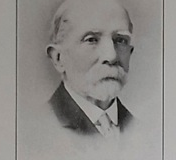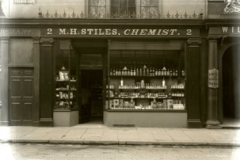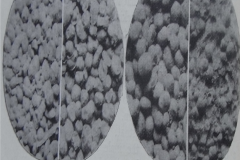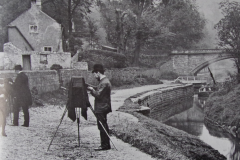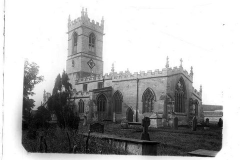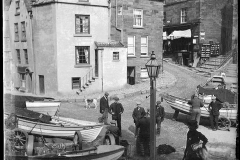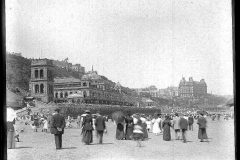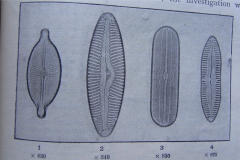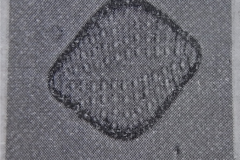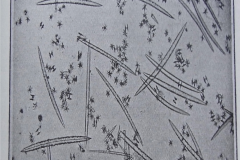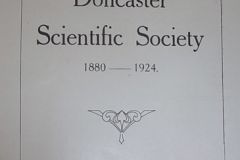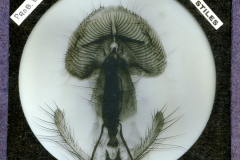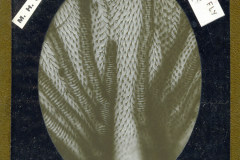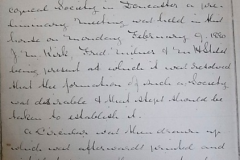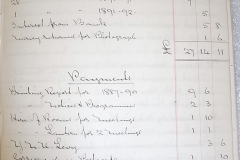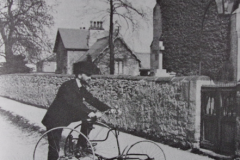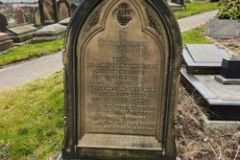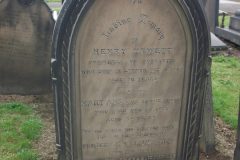Matthew Henry Stiles FRMS (1846-1935)
Notes compiled by Colin Howes and Pip Seccombe
Preface: The impetus for assembling this biography was a most fortuitous enquiry from Dr Jim McCormick of the Swedish Covenant Hospital, Chicago, USA. Dr McCormick, a lifelong enthusiast of 19th century microscopy and microscopists, had purchased a large collection of glass-plate negatives and photomicrographs at an auction in London. Some years later in proceeding to research their provenance, Dr McCormick had encountered Stiles’ name inscribed onto some of these items. In forwarding samples of Stiles handwriting …… [to be continued.]
Figure 1: Portrait of Matthew Henry Stiles at the age of 78 in ‘A Short History of the Doncaster Scientific Society 1924
Introduction: These biographical notes and bibliographies are based on literature searches of The Naturalist, YNU Transactions, the North Western Naturalist and the Journal of the Royal Microscopical Society, examinations of the Doncaster Naturalists’ Society Minute Books (1880 onwards) and the examination of Doncaster’s 19th and 20th century newspapers (Doncaster Chronicle, Doncaster Gazette and Doncaster Review) and Trade Directories. The biographical card index in the Natural Sciences section of Doncaster Museum contained 15 cards devoted to Matthew Henry Stiles, minutely annotated, often on both sides, largely by Dr. Peter Skidmore (Keeper of Natural Sciences 1965-1994), the late Leslie Smith (Doncaster Naturalists’ Society) and Denise Cutts (volunteer at Doncaster Museum in the 1970s).
Personal history: Born in Lutterworth, Leicestershire on 22 May 1846, Matthew Henry Stiles was one of a family of nine and at his death was survived by one sister who was ninety-two. Stiles and his wife Alice had six children but suffered the bereavements in infancy of their first son Harold Watson and first daughter Edith Mary. Their second daughter, Alice Dorothy died at the age of 11 on 10 November 1894. Of their three sons who survived to adulthood Fred died around 1915 and Edgar, who practiced as a solicitor in Berwick on Tweed and was Sheriff of that borough, died in France of bullet wounds during the First World War. Harry followed his father into the pharmaceutical profession, becoming a partner in the Stiles business and took over when his father retired on 3 January 1918 (Donc. Chron. 1935 and Dallman 1936).
A.A. Dallman (1883-1963), science master at Mexborough Secondary School and editor of the North-western Naturalist, knew Matthew Henry Stiles well through the Doncaster Scientific Society and recalled that he was most methodical and systematic in all he undertook, attributes which were sometimes almost carried to excess. He had been interested in scientific pursuits from early years, developing a remarkably wide, and in some cases a specialist, knowledge. Microscopy, Astronomy, Meteorology, Photography, and Botany all claimed his attention and in later life he became a Horticulturalist. He was skillful in working in wood and metal and created ingenious devices which he employed in his microscopical and photographic work (Dallman, 1936). One such device, the ‘Stiles Universal Microscope Lamp,’ was manufactured commercially by the microscope and optics firm W. Watson & Sons. (Roy. Mic. Soc.1909 and Watson, 1909).
The death of his wife Alice at the early age of 40 on 8 June 1889 could well have contributed to Matthew Henry dedicating the rest of his life to his various scientific, civic, educational and religious interests.
Matthew Henry Stiles as a Pharmacist: His apprenticeship as a pharmacist was served in the Warwickshire town of Rugby at the firm of S. Garratt’s Medical Dispensary. An interesting souvenir of this period, obtained by his biographer A.A. Dallman, was a 20-page booklet published in 1836 entitled “Catalogue of Genuine Drugs, Chemicals etc. etc., prepared and sold by S. Garratt’s Medical Dispensary, opposite the Spread Eagle Inn, Rugby (Established upwards of Twenty Years).” By way of introduction we read:
“Physician’s and Surgeon’s Prescriptions, and Family Recipes dispensed with great attention to accuracy and neatness. … Every drug and Chemical Preparation, as directed in the respective Pharmacopoeias of London, Dublin, and Edinburgh Royal College of Physicians. All Drugs and Chemicals sold by S. GARRATT are warranted to the first quality.”
This promotional booklet contained some quaint entries including “Arquabusade Cough Mixture, from recipes of the most eminent physicians; Best London Vinegar for pickling; Marshall’s Boot Top Powder; Oxygenated Fire Boxes; Instantaneous Fire Boxes; Pink and Blue Saucers; Pomade Divine; Lip Salve; Infant’s Preservative; Snooks’s Pills; Squire’s Grand Elixir; Sodiac Powders, for making Soda Water instantly, and finally A Constant supply of LEECHES always on hand.”
He continued his studies in London at the school of the Pharmaceutical Society, passing his examinations with credit. He was proud of the book prizes awarded to him in this connection in 1868, qualifying as a Pharmaceutical Chemist in July of that year. Matthew Henry came to Doncaster early in 1869 taking the post of senior assistant in the old established firm of pharmaceutical chemists, Dunhill & Shaw, continuing in this capacity until the expiration of the partnership in 1878. He then became partner in the firm with Alderman William Dunhill, carrying on the business under the name of “Dunhill and Stiles” (Dallman 1936). After Dunhill’s death in 1887 Matthew Henry became sole proprietor, running the business in his own name. In 1908 he took his elder son Harry into the partnership retiring from the firm on 3 January 1918. This long-established firm, the oldest chemist’s business in Doncaster, was wound up in the mid 1960s, the site being acquired as part of the Arndale (now Frenchgate) retail centre.
Figure 2: Photograph of the frontage of M.H. Stiles Chemist at 2 Frenchgate, Doncaster (Doncaster Museum Collection DONMAG 1976.194).
Royal Pharmaceutical Society: The professional body of the pharmacists claimed M.H. Stiles as their oldest member with an unbroken connection of seventy-two years, as student, associate and member (Dallman 1936).
Doncaster Pharmacists’ Society: Possibly a founder member in 1908 and by 30 November 1911 M.H. Stiles had been President of the organisation for two years.
Doncaster Microscopical Society, Microscopical and General Scientific Society, later the Doncaster Scientific Society, now the Doncaster Naturalists’ Society:
No survey or appreciation of his career and activities would be representative without reference to the Doncaster Scientific Society with which his life and work are conspicuously associated. The inception of the Society in 1880 resulted from a preliminary meeting between Matthew Henry Stiles, John Maw Kirk, Fred Milner and George Winter. As a result, the Doncaster Microscopical Society was founded. The Rev. Canon Brock, Curate of St. George’s was first President, holding office till 1885. Mr. Stiles was Secretary and Treasurer from 1880 to 1896, and he contributed the first paper to the new society on March 3, 1880, choosing as his topic, “The Microscope and how to use it.” The scope of the society was extended in the following year, when the title was changed to the Doncaster Microscopical and General Scientific Society. Later on, this gave place to the designation which it now bears (Dallman 1936). The following list summarises the posts held by Stiles.
- Founder Member in 1880 along with John Maw Kirk, Fred Milner and George Winter (for photographic portraits of the founder members see Stiles 1924).
- Hon. Sec. & Treasurer 1880 to 1896.
- President in 1889-90, 1896-97, 1904-05 and 1916-17.
- Committee member 1913-14.
- Vice President 1906-07, 1914-15, 1917-18, 1919-20, 1921-22.
- 13.5.1930 (DSS AGM) Matthew Henry Stiles FRMS was honoured by the Society by making him a Life Vice-President of the Doncaster Scientific Society.
- Microscopy Recorder 1906-1935.
- Physics Recorder 1918-1935.
- Photography Recorder 1928-1935.
Doncaster Museum (genesis of): M.H. Stiles was part of the sub-committee from the Doncaster Scientific Society which lobbied the Doncaster Corporation to establish a town museum. He read a ‘memorial’ to the Mayor of Doncaster suggesting the use of exhibition space in the Old Free Library. He then represented the Society on the Doncaster Museum and Art Gallery Committee 1906-07 to 1909-10, prior to the acquisition of Beechfield House as the first permanent home for the new museum.
Offices held in the Yorkshire Naturalists’ Union: Stiles joined the Yorkshire Naturalists’ Union along with his friend and fellow microscopist, John Maw Kirk, at the YNU excursion to Roche Abbey 18.5.1884 (The Naturalist 1884 10: 198-200). Here he took the remarkably detailed group photograph of the assembled naturalists (see Coles 2011 and Howes 2011).
The following list summarises the posts held by Stiles
- H. Stiles and George Tindall lead one of the fieldwork parties during the YNU Excursion to Doncaster 14.5.1883 (see The Naturalist 1882-83 8: 173-176).
- YNU Micro Zoology and Botany Committee formed in 1886 under the chairmanship of the illustrious Henry Clifton Sorby LL.D., FRS, FLS, FGS, FRMS.
- John Maw Kirk became its first secretary and Matthew Henry Stiles joined the Committee.
- After Kirk’s premature death in 1894 M.H. Stiles took over as Secretary/Convenor in 1895 remaining in the post till 1902.
- Sorby resigned as chairman in 1902, and M.H. Stiles was elected to the post in 1903 remaining in post at least till 1910 (The Naturalist 1911 36: 74-75) and was a regular contributor to the work of this section from producing 27 contributions between 1893 and 1934 (see bibliography).
Although the Micro-zoology and Micro-botany Committee changed emphasis in 1927 to become the Freshwater Biological Committee, Stiles and other individual microscopists continued to be active for some decades after and to publish papers in The Naturalist and elsewhere up to 1934. In formal recognition of his contribution to the Natural Sciences and services to the Yorkshire Naturalists’ Union, at the 71st Annual General Meeting of the Union held at the Bankfield Museum, Halifax on 10 December 1932, Mathew Henry Stiles FRMS was honoured by being elected an Honorary Member of the YNU (The Naturalist 1933 58: 13).
Royal Microscopical Society: Matthew Henry Stiles was elected Fellow of the Royal Microscopical Society in 1900 (Journal of the Royal Microscopical Society 41 (1923): 23-34).
In examining copies of the bi-monthly Journal of the Royal Microscopical Society 1878 to 1915 the notices of current research reviewed the following publications by M.H.Stiles:-
- R. Mic. Soc.1901: 219-220 Reviewed – Examination of Arsenical Sublimates. Pharmaceutical Journal (1901) lxvi: 4.
- R. Mic. Soc.1906: 695 Reviewed – Yorkshire Diatomaceae. The Naturalist (1906) 31: 128-129.
- R. Mic. Soc.1909: 218 Reviewed – Yorkshire Diatoms. The Naturalist (1908): 383-384.
- R. Mic. Soc.1911: 230 Reviewed – Algae of the Sheffield District. Handbook and Guide for
9th Meeting of the British Association for the Advancement of Science, Sheffield 1910:
232-241 [433-447 (Dallman 1936)].
Royal Meteorological Society: He was a fellow of the Royal Meteorological Society and for thirty years provided the air ministry with rainfall and other meteorological records monitored on instruments in his garden in Avenue Road. From 1915 to 1933 he reported on rainfall to the Doncaster Scientific Society (see appendix 3) and significant wet or drought periods were reported on to the Doncaster Gazette (Dallman 1936, Donc. Gaz.1935).
Public Education: He served as vice chairman of the Doncaster Corporation Higher Education Sub-committee and represented the West Riding County Council on the Committee of Doncaster School of Science and Art, the fore-runner of Doncaster Technical College and College of Art.
St. George’s Church (Doncaster ‘Parish’ Church, now the Minster Church of St George):
During his long life in Doncaster Matthew Henry Stiles was a devout supporter of the Parish Church and gave generously of his means, time and energy in this connection. His knowledge of ecclesiastical matters was extensive, and he held most of the offices open to laymen; these were principally as secretary of the Fabric Repair Fund and as Peoples’ Warden. He could claim associations with some seven or eight incumbents during his notable connection with the Parish Church. His enduring interest here was also illustrated by a bequest of two thousand pounds for Church purposes made in 1931 (Dallman 1936 Donc. Rev. 1898, Donc. Gaz.1935).
In determining which stone to employ for one restoration project MHS subjected samples of Jurassic Oolitic limestone from quarries at Casterton, Edithweeton, Ketton and Clipsham in Rutland to microscopical examination, reporting on the matter to the Doncaster Scientific Society on 9 October 1914 and publishing photomicrographs showing differences in microstructure of the samples (Stiles 1915). Prints of the photomicrographs were also exhibited at the Doncaster Scientific Society Exhibition in September 1925. Shortly after his eightieth birthday and confounding much younger members of the church community, he climbed to the top of the church tower to inspect progress on restoration work (Donc. Gaz.1935).
Figure 3: Micro structure of Oolitic Limestone samples from quarries in Rutland in (1) Casterton, (2) Edithweeton, (3) Ketton and (4) Clipsham (see Stiles 1915).
M.H. Stiles as an early Doncaster Photographer: In charting the development of photography in Doncaster through the late 19th century, Keith I.P. Adamson (1998) prominently featured the contributions of M.H. Stiles mainly through the forum of the Doncaster Microscopical and General Scientific Society.
In 1881 the Doncaster Microscopical Society widened its scope to include photography into its palate of activities and its secretary, Matthew Henry Stiles, delivered its first photographic lecture on 3 May 1882 describing ‘The Application of Photography to the Microscope’. A development he mentioned included the move from the old “wet collodian plates” to the “Gelatine dry plates which during the last few years had been extensively adapted for studio and other work…” and were proving to be “more suitable for photomicrography”.
On 16 January 1889 Stiles described the making of lantern slides, the exposed glass photographic plates being “developed with the aid of a hydroqinone developer … Processes for clearing and toning were then explained and the lecture concluded with the exhibition of a number of slides (including some very fine photo-micrographs) by the aid of an oxy-hydrogen lantern lent by the Lecturer.”
In 1889 reflecting the increase in trade in photographic equipment, Dunhill and Stiles, of 2 Frenchgate referred to themselves as Pharmaceutical and Photographic Chemists.
Early in 1890 the Microscopical Society held a Conversazione and Exhibition where photographs by George Bisat, W.I. Gent, W. Roberts, M.H. Stiles, and J.R. Thompson were exhibited.
During a photographic evening in March 1891 a number of excellent photographs were exhibited by Mr. W. Roberts, Mr. G. Bisat, Mr. M.H. Stiles, Mr. Whaley and Mr W.D. Watson. Also “during the evening Mr. Stiles gave a lantern exhibition of architectural views, photos of cathedrals, local scenes and a series of slides showing the construction and design of the Forth Bridge”.
In 1891 as a promotional offer, Dunhill and Stiles were advertising a half plate camera with three double backs, tripod and Wray Lens at £8 10s (£807.50 in today’s prices).
On 30 November 1892 in his talk ‘Notes on photographic printing’ Stiles described the use of the recently introduced Gelatine-chloride papers which made possible “different styles of finishing, resulting in the production of a highly glazed or enamel surface, a dull or matt surface also a medium surface similar to that of albuminised paper …” and on 6 December 1893 spoke to the society on ‘Improvements in Bromide Printing’.
Figure 4: Photographers [including John Maw Kirk (left) by the South Yorkshire Navigation at Sprotbrough (Doncaster Museum Collection DONMAG 1976.194).
The presence of sets of Lantern slides from ‘foreign countries’ in Dr McCormick’s M.H. Stiles collection may be explained, as Stiles and his Doncaster contemporaries regularly gave ‘improving’ Lantern Slide shows to ‘worthy’ local organisations like the YMCA and Church groups, often drawing huge audiences. For instance, in 1892 the YMCA showed a number of photographically illustrated talks with subjects including the ‘Chicago World Fair’, the ‘Egyptian Campaign’ [The Mahdist War (1881-1899)], a ‘Visit to Venice’ and the ‘Eruption of Mount Etna’. On 15 November 1911 Stiles showed Lantern Slides of ‘A Holiday in Belgium’ to the Doncaster Scientific Society and on 23 March 1927 he gave an illustrated lecture to the society on ‘Early Glimpses of Doncaster’. In 1928 Stiles prepared Lantern Slides for Dr. S.P. Rowland’s Presidential Address to the society on the subject of ‘With the Red Cross in Serbia’. He also prepared Lantern Slides for Miss I. Brunner for her lecture to the society on ‘Rowtor Rocks’ the gritstone outcrop in the Derbyshire Peak District.
Topographical photographs: In 1976 a batch of Stiles’s glass plate negatives came up for sale at Stainland’s Auction Rooms in Netherhall Road, Doncaster and Doncaster Museum was successful in acquiring them for £40, the vendor being a Miss A.E. Robinson. This collection which currently resides at Cusworth Hall Museum, Doncaster, consisted of some 433 glass plate negatives, 53 prints mounted on 6½ x 5½ inch card mounts and 50 prints mounted on 5 x 4inch card mounts, all mounts with rounded corners and gilded chamfered edges. The card mounted examples are largely prints taken from the glass plate negatives by Stiles and labelled in his characteristic handwriting (DONMAG 1976.194).
Stiles toured the Doncaster region with his photographic equipment, possibly on his Otto or other cycles, recording local subjects and themes including street scenes, landscapes, buildings (including churches, country houses and castles, see Appendix 1 & 2) canals/river scenes, harvest time, winter snow scenes. Of particular interest were the images of the riverside quarrying and barge building village of Levitt Hagg, the area around Sprotbrough lock, Edward VII at Doncaster Races and the first UK Air-show held on Doncaster Race Course 15 to 23 October 1909. From further afield were images from his home village of Lutterworth and from excursions to the Yorkshire coastal resorts, Wharfedale, Richmond, the English Lake District, Isle of Man and parts of Scotland. His travels to holiday resorts on the Yorkshire coast are captured in the examples from Robin Hood’s Bay (Fig. 6), Staithes (Fig 7) and The Spa, South Bay, Scarborough (Fig. 8). Since these and others from the Whitby area were similar in location and theme to those taken by his contemporary Frank Meadow Sutcliffe, prints were examined by Michael Shaw, proprietor of the Sutcliffe Gallery, Flowergate, Whitby who confirmed that on technical, stylistic and historical grounds they were not by Sutcliffe.
Figure 5: St Peters Church (The Cat and Man Church) Barnburgh, Doncaster.
(Colln. of Dr Jim McCormick).
Figure 6: Cobles (fishing boats) on the slipway at Robin Hood’s Bay (Colln. of Dr Jim McCormick).
Figure 7: Fisher girl carrying lobster pot posing for a photograph (after the style of Frank Meadow Sutcliffe) in the seaside village of Staithes (Colln. of Dr Jim McCormick).
Figure 8: Promenaders on the beach at the Spa, South Bay, Scarborough. In the distance on the right stands the Grand Hotel (Colln. of Dr Jim McCormick).
Published Photographs: Though Stiles’ topographical photographs would have been viewed at numerous meetings and exhibitions of the Doncaster Scientific Society and no doubt other organisations such as church groups and the YMCA, only one example seems to have been published under his name during his lifetime. This was on the front cover of the April 1897 edition of the monthly journal The Doncaster Review. This featured a Humber Keel in full sail on the River Don/South Yorkshire Navigation at Sprotborough (Stiles, 1897).
A selection of late 19th to the turn of the 20th century images from Doncaster and its region from the Stiles collection (DONMAG 1976.194) formed the majority of the photographic images in the series of three booklets entitled Doncaster Yesterday compiled by T.G. Manby and published by Doncaster Museums & Arts Service. These were No.1: About the town; No.2: The new century and No.3: A day in the country (Manby, 1980; 81; 83).
Publications: (Diatom studies) During excursions in the field with the Doncaster Scientific Society and the Yorkshire Naturalists’ Union he collected samples of Diatoms from Adwick Dam SE5408; Askern (sub-fossil earth by Shirley Bog SE5612), (Shirley Pool SE5611); Bentley SE5705; Cadeby (spring) SK5100; Cusworth lower Lake SE552036; Firsby Reservoirs SK4995; Hampole Brook SE5010; Hatfield Brickpond SE6610; Hatfield West Moor SE6406; Ilkley (Streamlet nr. Tarn); Martin Beck SK6294; Potteric Carr SE5900; Roche Abbey SK5489; Rossington SK6298; Sandall Brickpond SE6005; Scawthorpe SE5505; Skellow Brook (at Skelbrooke Park) SE5112; Skellow Pool SE5210; Skellow Dam SE5210; Stone SK5589; Thorpe Brick Pond SE5910; Thrybergh Reservoir SK4795; Red House Pond (Donc. Racecourse) SE6003; River Went at Wentbridge SE4917 and Wrancarr Drain SE5812. Since the rural, urban, and industrial landscapes and drainage patterns have changed enormously since Stiles’ day only approximate OS grid references have been assigned.
He supplied material which Messrs. W. and G.S. West utilised in their Alga-Flora of Yorkshire (1901). The following quotations referring to Stiles’ contributions (West & West pp. 9-10 and 443-447) were kindly abstracted for us by Prof. Mark Seaward.
“Mr. M.H. Stiles sent us some slides of diatoms from near Doncaster and followed up this action by very kindly placing at our disposal a full and valuable list of the diatoms of that district. In his list were enumerated about 125 species and many varieties, about a dozen of each of which were additions to the flora. Of those localities vouched for by Mr. Stiles ‘Askern district’ includes Askern, Wrancar Drain, and Thorpe brickpond; ‘Cusworth district’ includes Cusworth, Scrawthorpe and Bentley; and ‘Hatfield district’ includes Hatfield West Moor, Hatfield brickponds, and Sandall brickpond; ‘Doncaster Town Water’ is from Firsby, Thrybergh, and Sheffield.”
The article on Algae and Diatomacae in the Handbook of the British Association for the Advancement of Science Handbook, prepared for their meeting in Sheffield in 1910, was from his pen and repeated in the Proceedings and Annual Report of the Sheffield Naturalists’ Club for 1910.
In addition he published some twenty-seven papers and notes on diatoms, the last and perhaps most significant, based on a sample of diatomaceous earth from Kentsmere in the Lake District, Westmoreland. Here, the discovery of a 100 acre 15 ft thick deposit of Diatomaceous earth, worked by the Kentmere Diatomite Co., Ltd., aided by the Leeds Fireclay Company, led to a sample being examined by M.H. Stiles. The resultant report (Stiles, 1934) described the complex methodology of preparing the raw material for final examination and revealed the discovery of Navicula hitchcockii a species, though frequent in America was only previously known from the Loch Oich deposit (Caledonian Canal) and nowhere else in Europe.
Taxonomic keys referred to by M.H. Stiles and presumably contained in his library included:
Donkin, A.S. (1871-73) Natural History of the British Diatomacae. Van Voorst, London.
Prichard, A[ndrew] (1861) A history of Infusoria: including the Desmidiaceae and Diatomacae,
British and foreign. Whittaker and Co. London.
Van Heurck, Henri (1896) A Treatise on the Diatomaceae. London, William Wesley & Son.
[Translated by Wynne E. Baxter] 20: 558. 25 pages of plates.
The following papers on Diatoms and five other writings arranged in chronological order represent Stiles’ published output from 1893 to 1934:
Stiles, M.H. (1893) YNU Circular 109 for Excursion Askern 15 June 1893:
Micro-Zoology & Botany.
Stiles, M.H. and Newton-Coombe, J. (1893) [Micro-zoology and botany] in The Yorkshire
Naturalists’ at Askern. The Naturalist 18: 292-3.
Stiles, M.H. (1895) Provisional list of Diatoms found at Cusworth, near Doncaster.
The Naturalist 20: 62
Newton-Coombe, J. and Stiles, M.H. (1899) Diatoms observed at Hatfield West Moor, near
Doncaster. The Naturalist 24: 49-51.
Stiles, M.H. (1900) List of Diatoms found near Doncaster. The Naturalist 25: 325-30.
Stiles, M.H. (1900) Freshwater Sponges in Yorkshire. The Naturalist 25: 331.
Stiles, M.H. and Philip, R.H. (1901) Yorkshire Naturalists’ at Brough: Diatoms. The Naturalist
26: 223-235.
Stiles, M.H. (1901) YNU circular 162 for Excursion to The Don Valley, Conisborough to Doncaster
(VC63) 26 September 1901: Micro-Botany & Micro-Zoology.
[Stiles 19th century records incorporated in West, W. and West, G.S. (1901) The Alga-Flora of
Yorkshire. Botanical Transaction of the Yorkshire Naturalists’ Union Vol 5.]
Stiles, M.H. (1902) YNU 40th Annual Report for 1901: Micro-Zoology and Micro-Botany Committee.
YNU Transactions Pt. 29: 132.
Stiles, M.H. (1902) YNU circular 166 for Excursion to Bawtry (VC63) 10 July 1902: Micro-Zoology & Micro-Botany.
Stiles, M.H. (1902) Yorkshire Naturalists’ at Conisbrough and Doncaster. Micro-zoology and botany:
Diatoms. The Naturalist 27: 121.
Stiles, M.H. (1903) YNU 41st Annual Report for 1902: Micro-Zoology and Micro-Botany Committee.
YNU Transactions Pt. 29: 176.
Stiles, M.H. (1903) YNU Circular for Excursion to Wharncliffe Crags 3 September 1903: Algae.
Stiles, M.H. and Moore, H. (1903) Yorkshire Naturalists at Wharncliffe: Micro-Botanical and Micro-
zoological Section. The Naturalist 28: 401-402.
Stiles, M.H. (1906) Yorkshire Diatoms in 1905. The Naturalist 31: 128-9.
Stiles, M.H. and Philip, R.H. (1906) Diatoms at Askern. The Naturalist 31: 428.
Stiles, M.H. (1908) [Diatoms] in Yorkshire Naturalists’ at Hampole. The Naturalist
33: 383-4.
Stiles, M.H. (1910) Algae and Diatomaceae pp. 443-447. In the Handbook and Guide for the
9th meeting of the British Association [for the Advancement of Science] in Sheffield.
Stiles, M.H. (1910) Algae and Diatomaceae pp. 47-91. In Proceedings of the Sheffield Naturalists’
Club Vol. 1. together with the Annual Report for 1910.
Stiles, M.H. (1910) YNU Circular 226 for Excursion (with Lincolnshire Naturalists Union) to
Scunthorpe, North Lincs. 25 August 1910: Algae M.H. Stiles.
Stiles, M.H. (1906) YNU Circ. 196 for Excursion to Askern 12 July 1906 Micro-Zoology and Botany.
Stiles, M.H. (1912) Yorkshire Naturalists’ at Askern: Diatoms. The Naturalist 37: 257-8.
Stiles, M.H. (1918) The Diatoms of Martin Beck, Yorks. The Naturalist 43: 281-3.
(Illust. Navicula pusilla, N. alpine. N. americana, N. ignota).
Stiles, M.H. (1926) Notes on Cocconeis distans (marine diatom) from Went Valley.
North Western Naturalist 1 (1): 39.
Stiles, M.H. and Bellamy, R.A. (1928) The Diatom Flora of the River Went. The Naturalist
53: 171-173. (Illust.).
Stiles, M.H. (1931) Diatom Flora of Potteric Carr. The Naturalist 56: 122.
Stiles, M.H. (1934) Kentmere Diatoms. North Western Naturalist 9: 124-127.
Figure 9: (1) Navicula pusilla, (2) N. alpine. (3) N. americana and (4) N. ignota) from ‘The Diatoms of Martin Beck, Yorks’. (Stiles 1918).
Figure 10: Cocconeis distans var. wentica var. nov. from ‘The Diatom Flora of the River Went’ (Stiles & Bellamy,1928).
Publications: (Other subjects)
Stiles, M.H. (1895) In Memoriam: John Maw Kirk, FRMS, Born November 7th, 1850, Died October 31st, 1894. The Naturalist 20: 113-115.
Stiles, M.H. (1900) Freshwater Sponges in Yorkshire. The Naturalist 25: 331. (Illust.).
Figure 11: Photo-micrograph showing Freshwater sponge spicules from a sample taken from Manchester Reservoir (Stiles, 1900).
Stiles, M.H. (1901) Examination of Arsenical Sublimates. Pharmaceutical Journal lxvi: 4.
(Dallman 1936). [the work carried out to assist the late E.M. Holmes FLS Curator of the Royal Pharmaceutical Society].
Stiles, M.H. (1915) Structure of Oolitic Limestone The Naturalist 40: 62-63. (Illust.).
Stiles, M.H. (1924) A Short History of the Doncaster Scientific Society.
Doncaster Scientific Society, Doncaster. [250 copies printed see DSS Minutes 11.3.1924]
Figure 12: Front cover of ‘A Short History of the Doncaster Scientific Society
1880-1924’ (Photo by Pip Seccombe).
Yate-Allen, Rev. M. (1926) Rare Rotifers near Doncaster. The Naturalist 51: 305-306. (Illust.)
[line drawings based on photomicrographs by the 80-year-old M.H. Stiles].
Examples of handwriting and calligraphy: Stiles’ printed name labels attached to some glass lantern slides (see Figure 13) in the otherwise anonymous collection of glass plate negatives, photomicrographs of diatoms and invertebrates and other lantern slides purchased in 1979 by Dr Jim McCormick of Illinois, USA provided the initial suggestion that the collection may have been the work of Matthew Henry Stiles, founder member of the Doncaster Microscopical Society and published diatomist.
Figure 13: Lantern slides with printed labels of M.H. Stiles.
Ex. Collection. Dr J. McCormick.
Stiles’ role as Hon. Secretary and Hon. Treasurer of the Doncaster Microscopical Society has been key in verifying this possible link with other material in the collection. At Dr McCormick’s request, examples of Stiles’ characteristic hand writing using both script and figures preserved in the society minute books held in the society archives at Doncaster Museum were photographed by Pip Seccombe (see Figs 14 and 15). These, Dr McCormick forwarded to the forensic handwriting analyst and document examiner Patricia Fisher of the Board of Forensic Examiners, Albany, California, USA who had been commissioned to judge the likelihood of writings and annotations on a sample of three glass plate negatives of diatoms being by Matthew Henry Stiles. Her conclusions were that it was most likely that M.H. Stiles wrote on the three slides.
Figure 14: First page from the inaugural minutes of the Doncaster Scientific Society 9 February 1880 held at the home of J.M. Kirk where M.H. Stiles was Secretary and Treasurer. (Photo. by Pip Seccombe).
Figure 15: Hand writing/calligraphy of M.H. Stiles in Treasurers report for the Doncaster Scientific Society 1890-91 (Photo. by Pip Seccombe).
Subsequent comparisons using known examples of Stiles’ photographs both published and in Museum collections and biographical studies of Stiles as a naturalist, microscopist and photographer have further helped to confirm the photographer to have been Matthew Henry Stiles.
Talks & Demonstrations: From the first lecture to the newly formed Doncaster Microscopical Society on 3 March 1880 through to 28 September 1933, Matthew Henry Stiles regularly gave talks, lantern slide shows, demonstrations and read papers on his researches to a range of organisations but primarily to the Doncaster Scientific Society. Examples on over 120 dates recorded in the minutes and publications of the Doncaster Scientific Society (see Appendix 3) cover subjects including Meteorology (50 examples), Microscopy (43), Photography (23), Diatoms (10), Vascular plants (4), Entomology (2), Geology (2), Astronomy (2) and Local history (2). Lantern slide shows were also given to organisations such as local church groups and the YMCA and are referred to in Adamson (1998) but have not been extensively researched.
M.H. Stiles as a Cyclist: On 12 June 1885 M.H. Stiles published a letter announcing the formation of an ‘Otto’ riders club in Doncaster. The inaugural meeting on 15 June 1885 was to be held at Walter Roberts house in St. Sepulchregate. The Otto was an early form of safety bicycle – its two-track format was referred to as a ‘Dicycle’ to differentiate it from the in-line two wheelers. The machine had the advantages of a tricycle in its low riding position and open front allowing it to be ridden by women wearing skirts. Furthermore, as balance was achieved by fore and aft, rather than side-to-side motion, novice riders were merely pitched forward on to their feet in learning to ride the machine, a rear jockey wheel preventing a backward fall. So effectively could the machine be controlled that legend has it that it was demonstrated to the Board of BSA (the Birmingham Small Arms Co. Ltd.) by being ridden from one end of the boardroom table to the other.
BSA was formed in 1861 and commenced building bicycles around 1870. In the 1880s BSA built many tricycles which were badged by other manufacturers such as the Matchless Bicycle and Tricycle Co. BSA also manufactured the Otto dicycle of which some 2,000 were thought to have been built, but only a handful are known to survive. The Otto was one of only two machines the company built in the 19th century – the other being an equally rare safety bicycle of 1885-6.
He was a keen cyclist through most of his life only giving up cycling when he was eighty (Donc. Gazette 1935).
Figure 16: Cyclist [? M.H. Stiles] on a tricycle outside St Lawrence’s Church, Adwick-le-Street (Doncaster Museum collection DONMAG 1976.194).
Wheatley Golf Club: Matthew Henry took up golf on his sixtieth birthday playing firstly on Doncaster Common, then briefly at Doncaster Warren and finally at the more conveniently local Wheatley Golf Course. He celebrated his eightieth birthday by playing a round on the Wheatley Course with the club captain, one of his Avenue Road neighbours, Mr. John P. Bone (Donc. Gaz., 1935).
Funeral: Matthew Henry Stiles died at his home at 10 Avenue Road on 9 May 1935 after a brief illness just thirteen days short of his 88th birthday.
The Doncaster Chronicle and Doncaster Gazette (16 May 1935) reported that those who attended his funeral on 10 May included the following –
(Chief mourners) Mr and Mrs Harry Stiles* (Son and daughter-in-law), Miss Evelyn M. Schofield (MH’s companion), Mr. and Mrs. Avory Parkin* (Godson), Mr. C.H. Clark*, Mr. T. Milnes, Mr. Fred A. Jordan*. Other mourners included Councillor T.H. Johnson; Mr. Norman Smedlay* (curator of Doncaster Museum); Rev. E.A. Armstrong (a former curate at Doncaster Parish Church and now in Leeds) [also author of the Collins New Naturalist Monograph ‘The Wren’ (1955), New Naturalist volume on ‘The Folklore of Birds’ (1958)]; Mr. G.L. Sutcliffe (President of the Doncaster Scientific Society), Mr. A.A. Dallman (DSS Vice President), Mr. J. Dufty (DSS Vice President), Dr. S.P. Rowlands* (DSS Scientific Secretary), Mr. L. Smith (DSS Hon. Secretery), Mr. D.T. Livesey* (former DSS Hon. Secretary), the Reverend J.A. Claxton (DSS), Miss S. Jennings (DSS); Mr. H.W. Shaw (representing Doncaster Pharmacists’ Society); Mr. E. Farr and Mr. R.H. Farr (neighbours in Avenue Road); Dr. A.E. Huckett*; Mr. J. Ibbotson; Mr. F. Mahon; Mr. J.S. Nettleton; Mr. P.W. Schofield and Mr. Spencer Baker.
Wreaths (*) were sent on behalf of the Doncaster Scientific Society; Yorkshire Naturalists’ Union and the Wardens and Parochial Council of Doncaster Parish Church, also by Harry, and Pansy (Son and Daughter in law); Mr. and Mrs. A.J. Batty; relatives of the late G. Bisat; someone referred to as ‘John Bull’ and neighbours in Avenue Road Mr. and Mrs. George Mitchell, Mr. and Mrs. Ward, Mr. and Mrs. Alfred Woodmansey also Eileen, Ernest, Nellie and the boys; Elsie and Frank; Nora; Susan, Diana, Peter and Shirley.
Headstone and Inscription in Doncaster Hyde Park Cemetery:
(Transcribed 9.7.2010)
IN
LOVING MEMORY
OF
ALICE
WIFE OF MATTHEW HENRY STILES
WHO DIED JUNE 8 1889
AGED 40 YEARS
ALSO OF
HAROLD WATSON AND EDITH MARY
CHILDREN OF THE ABOVE
WHO DIED IN INFANCY
AND OF ALICE DOROTHY THEIR CHILD
WHO DIED NOV. 10 1894 AGED 11 YEARS
ALSO Matthew henry
Husband of the above alice stiles
Who died may 9, 1935 aged 88 years
Figure 17: Headstone at the Stiles family grave, Hyde Park Cemetery, Doncaster (Photo by Pip Seccombe 2010).
Acknowledgements:
Doncaster Scientific Society Minute Books, copies of The Naturalist, The North-western Naturalist and Proceedings of the Royal Microscopical Society were made available at Doncaster Museum. Thanks are due to Laura Nugent, Registrar at Doncaster Museum and Arts Service for accession details and for access to the Natural History biography card index and Doncaster Naturalists’ Society Archives, to Nicola Fox, Social Historian at Cusworth Hall Museum for assistance in examining the Stiles photographic collection (DONMAG 1976.194) and to Dr. Terry Manby (former Curator of Doncaster Museum) for drawing our attention to the Stiles photographs published in the ‘Doncaster Yesterday’ booklet series. Local Studies staff at Doncaster Central Library provided access to the West Yorkshire trade directories, the Doncaster Review and microfilm archives of the Doncaster Chronicle and Doncaster Gazette. Thanks are due to Prof. Mark Seaward (University of Bradford) for abstracting information from West & West (1901). We are also grateful to Michael Shaw of the Sutcliffe Gallery, Whitby for his expert advice.
References:
Adamson, K.I.P. (1998) Photographers in Victorian Doncaster 1842-1900.
Doncaster Museum Services, Doncaster.
Anon. (1909) ‘Stiles Universal Microscope Lamp.’ Journ. Roy. Mic. Soc. (3): 399.
Coles, G (2011) The Story of South Yorkshire Botany. Yorkshire Naturalists Union,
Dallman, A.A. (1936) Obituary: Matthew Henry Stiles (1846-1935). North Western
Naturalist 10 (3): 270-274.
Doncaster Chronicle (1935) Old Doncaster Worthy: Mr. M.H. Stiles. 16.May 1935. p.10.
Doncaster Gazette (1935) A Victorian Passes: Death of Mr. M.H. Stiles. 16 May 1935 p.11.
Doncaster Review (1897) The River Don at Sprotborough 40 (April): 37. (Illust.).
Doncaster Review (1898): 56
Howes, C.A. (2011) Matthew Henry Stiles. The Naturalist 136: 200.
Manby. T.G. (1980) Doncaster Yesterday No.1: About the town. Doncaster,
Museums & Arts Service, Doncaster.
Manby. T.G. (1981) Doncaster Yesterday No.2: The new century. Doncaster
Museums & Arts Service, Doncaster.
Manby. T.G. (1983) Doncaster Yesterday No.3: A day in the country. Doncaster
Museums & Arts Service, Doncaster.
Watson, W. & Sons. (1909) 1909 Catalogue. p.122-3.
West, W. and West, G.S. (1901) The Alga-Flora of Yorkshire. Botanical
Transaction of the Yorkshire Naturalists’ Union Vol 5.
| Appendix 1: Churches and other Ecclesiastical buildings featured in Matthew Henry Stiles Collection of Photographs held at Doncaster Museums & Arts Service (DONMAG 1976.194). | |
| Name | OS Grid Ref. |
| Adwick-le-Street (St. Laurence) | SE540086 |
| Arksey (All Saints) | SE579068 |
| Barnby Dun (St. Peter & St. Paul) | SE614097 |
| Barnburgh (St. Peter) | SE484032 |
| Bawtry (St. Nicholas) | SK654930 |
| Birkin (St. Mary) | SE530265 |
| Blyth (St. Mary & St. Martin) | SK624873 |
| Burghwallis (St Helen) | SE536120 |
| Campsall (St. Mary) | SE544140 |
| Cantley (St. Wilfrid) | SE618014 |
| Conisbrough (St. Peter) | SK512987 |
| Doncaster Minster (St. George) | SE574036 |
| Doncaster (Christchurch) | SE579033 |
| Fishlake (St. Cuthbert) | SE656131 |
| Hatfield (St. Laurence) | SE663095 |
| Hickleton (St. Wilfrid) | SE483053 |
| Hooton Pagnell (All Saints) | SE485079 |
| Howden Minster (St. Peter & St. Paul) | SE748282 |
| Kirk Bramwith (St. Mary) | SE619117 |
| Kirk Sandall (St. Oswald) | SE609081 |
| Kirk Smeaton (St. Peter) | SE520166 |
| Loversall (St. Katherine) | SK576987 |
| Marr (St. Helen) | SE514053 |
| Old Edlington (St. Peter) | SK533973 |
| Owston (All Saints) | SE551111 |
| Sandbeck Hall Chapel | SK568903 |
| Sprotbrough (St. Mary the Virgin) | SE539020 |
| Thrybergh (St. Leonard) | SK466954 |
| Tickhill (St. Mary) | SK591930 |
| Warmsworth (Belfrey) | SE547005 |
| Wentbridge (St. John) | SE490173 |
| Lutterworth (St. Mary) Leicestershire | SP544844 |
| Bolton Abbey | SE074541 |
| Fountain’s Abbey | SE271683 |
| Furness Abbey (Lake District) | SD220716 |
| Melrose Abbey (Scotland) | NT548341 |
| Roche Abbey (South Yorkshire) | SK544898 |
| Peterborough Cathedral | TL194986 |
| Appendix 2: Country Houses and Castles featured in Matthew Henry Stiles Collection of Photographs held at Doncaster Museums & Arts Service (DONMAG 1976.194). | |
| Name | OS Grid Ref |
| Bawtry Hall | SK650928 |
| Beechfield House, Doncaster | SE577030 |
| Blyth Hall | SK622873 |
| Conisbrough Castle | SK514988 |
| Richmond Castle | NZ171007 |
| Sandbeck Hall | SK568903 |
| Sprotbrough Hall | SE540019 |
| Tickhill Castle | SK593929 |
| Warmsworth Hall | SE546006 |
| Wheatley Hall | SE584052 |
| Appendix 3: Talks, Reports, Demonstrations and Exhibitions by
Matthew Henry Stiles 1880-1933 |
||
| DMS | Doncaster Microscopical Society | |
| Key: | DMGSS | Doncaster Microscopical and General Scientific Society |
| DSS | Doncaster Scientific Society | |
| AGM | Annual General Meeting | |
| Date | Organisation | Talks, Reports, Demonstration and Exhibition |
| 3.3.1880 | DMS | M.H. Stiles contributed the first paper to the newly established society, choosing as his topic ‘The Microscope and how to use it’. |
| 3.5.1882 | DMGSS | Demonstration on ‘Application of photography to microscopy’. |
| 25.10.1892 | DMGSS | Showed Blow fly under Microscope. |
| 22.10.1883 | DMGSS | Demonstration. Set up a microscope. |
| 28.11.1883 | DMGSS | Demonstration. Set up a microscope. |
| 28.11.1883 | DMGSS | Exhibited a ‘Harmonograph’, an instrument for ruling harmonic curves. |
| 28.11.1883 | DMGSS | Experimented with an air pump belonging to Canon Brock. |
| 7.4.1886 | DMGSS | Gave talk on ‘The ways of Insects’. |
| 3.11.1886 | DMGSS | Gave talk on ‘Photomicrography’. |
| 24.11.1886 | DMGSS | Gave talk on ‘Milk, its chemical and microscopical examination’. |
| 16.2.1887 | DMGSS | Gave talk on ‘Bees and their work’ |
| 21.12.1887 | DMGSS | Gave talk on ‘Photography in artificial light’. |
| 25.4.1888 | DMGSS | Gave talk on ‘Producing satisfactory prints from under exposed conditions’. |
| 16.1.1889 | DMGSS | Gave talk on ‘Lantern Slides and how they are made’. |
| –.5.1889 | DMGSS | (Conversazione at Doncaster Mansion House) Set up microscopes illuminated with electric light and exhibited instruments for photographic analysis etc. (see Doncaster Chronicle 3.5.1889). |
| 29.1.1890 | DMGSS | Showed photographs and set up a microscope. |
| 19.2.1890 | DMGSS | Gave talk on ‘Improvements in photomicrography’. |
| 30.11.1892 | DMGSS | Gave talk on ‘Notes on photographic printing’. |
| 13.4.1893 | DMGSS | Set up microscope and exhibited living Volvox and showed photographs. |
| 6.12.1893 | DMGSS | Gave talk on ‘Improvements in Bromide Printing’. |
| 18.10.1894 | DMGSS | Conversazione at Doncaster Mansion House) Demonstration (with George Winter & Walter Roberts) showing changes in microscopes. |
| 20.11.1895 | DMGSS | Demonstration. Set up microscope and showed photographs. |
| 11.3.1896 | DMGSS | Demonstration. Set up microscope and showed photographs. |
| 12.11.1896 | DMGSS | Demonstration. Set up microscope and showed photographs. |
| 9.12.1896 | DMGSS | Reported Achanthus exilis, a Diatom from Bentley new to the Doncaster District. |
| 10.2.1897 | DMGSS | Gave talk on ‘Diatoms and their sources’. |
| 10.3.1897 | DMGSS | Gave talk on ‘The Polariscope and polarised light. |
| 24.3.1897 | DMGSS | Gave report on Diatoms etc. from Cusworth Lakes
(see Stiles 1895). |
| Autumn 1897 | DMGSS | Gave Microscopy report which included lists of records from the Hatfield Chase, Cusworth, Deffer Wood, Cannon Hall Park ponds & lakes, Sandall Brick Ponds. |
| 23.2.1898 | DMGSS | Gave Microscopy report including Diatoms etc. lists from the Scawthorpe area and Askern Bog (earth). |
| 13.4.1898 | DMGSS | Gave report on Diatoms from old Bog Earth at Askern (new to the Doncaster District). |
| 12.10.1898 | DMGSS | Gave report in great detail on ‘the most active year since the founding of the Society’ in the field of microscopic life. He worked with Mr Newton-Coombe of Sheffield on the YNU meeting (see Stiles & Newton-Coombe 1893 and Naturalist (1899) 24: 49-51). |
| 5.4.1899 | DMGSS | Showed Lycopodium clavatum from Hatfield Moors. The specimen given by a Hatfield resident who knew the moor and confirmed that the plant was truly wild there. |
| 11.10.1899 | DMGSS | Gave report on Microscopy featuring Diatom records from Roche Abbey and Hatfield Brick Ponds where he first found the alga Volvox globator with his friend Mr. J.M. Kirk. |
| 23.11.1899 | DMGSS | Gave report on ‘Diatoms in Doncaster Water’ (see Stiles 1900). |
| 23.1.1901 | DMGSS | Gave talk on ‘Arsenic in beer, its source and detection’ (See Stiles 1901). |
| 12.10.1904 | DMGSS | Gave talk on ‘The history of the Society 25 years ago’. |
| 27.3.1907 | DMGSS | Gave report on Volvox globator, its natural history and local distribution. |
| 15.11.1911 | DMGSS | Showed Lantern Slides of ‘A Holiday in Belgium’. |
| 26.3.1913 | DSS | Gave talk on ‘Photo Micrography in Natural Colours’. |
| 8.10.1913 | DSS | Gave report on Physics. |
| 3.12.1913 | DSS | Gave report on Physics. |
| 22.4.1914 | DSS (AGM) | Gave report on Microscopy & Physics. |
| 9.11.1914 | DSS | Gave report on Geology (micro-photographs of Oolitic limestone) (see Stiles 1915). |
| 9.11.1914 | DSS | Gave report on Physics (Rainfall) and Transit of Mercury. |
| -.4.1915 | DSS (AGM) | Gave report on Microscopy & Physics. |
| 27.10.1915 | DSS | Gave report on Physics (Rainfall). |
| 10.11.1915 | DSS | Gave report on Physics (Rainfall). |
| 12.1.1916 | DSS | Gave report on Physics (Rainfall). |
| -.4.1916 | DSS (AGM) | Gave report on Microscopy & Physics (Rainfall). |
| 24.10.1916 | DSS | Gave Presidential Address ‘Photography with the Microscope’ |
| 28.2.1917 | DSS | Gave report on Physics (Rainfall). |
| 24.10.1917 | DSS | Gave report on Physics (Rainfall). |
| 23.1.1918 | DSS | Gave report on Diatoms at Martin Beck Wood (see Stiles 1918). |
| -.2.1918 | DSS | Gave report on Microscopy (Diatoms at Martin Beck Wood) (see Stiles 1918). |
| 6.3.1918 | DSS | Gave report on Physics (Rainfall). |
| -.4.1918 | DSS (AGM) | Gave report on Microscopy (Diatoms). |
| 13.11.1918 | DSS (Exhibition) | Organised exhibition of Microscopy to which he loaned scientific instruments. |
| -.1.1919 | DSS | Gave report on Physics (Rainfall). |
| 12.2.1919 | DSS | Gave report on recent heavy rainfall. |
| 26.6.1919 | DSS | Described the interesting Astronomical objects now to be seen and invited DSS members to come to his home (10 Avenue Rd.) on a suitable night to use his telescope. |
| -.4.1919 | DSS (AGM) | Gave report on Microscopy. |
| 5.11.1919 | DSS | Gave report on Physics (Rainfall). |
| 21.1.1920 | DSS | Gave report on Physics (Rainfall). |
| 4.2.1920 | DSS | Gave lecture on ‘Foods and their Dietetic Value’. |
| -.4.1920 | DSS (Exhibition) | Contributed Microscopy items to Exhibition at Parkinson’s shop [Doncaster High Street]. |
| 21.4.1920 | DSS (AGM) | Gave report on Physics (Rainfall) and Microscopy. |
| 10.11.1920 | DSS | Gave report on Physics (Rainfall). |
| 8.12.1920 | DSS | Gave report on Physics (Rainfall). |
| 16.2.1921 | DSS | Gave report on Physics (Rainfall). |
| -.4.1921 | DSS (Exhibition) | In charge (with G.B. Bisat) of Microscopy section. |
| 20.4.1921 | DSS AGM | Exhibited chart of Doncaster Rainfall over the past 15 years |
| 12.10.1921 | DSS | Gave report on Physics (Rainfall). |
| 14.12.1921 | DSS | Gave lecture on ‘The Hardness of Water.’ |
| 14.12.1921 | DSS | Gave report on Physics (Rainfall). |
| 25.1.1922 | DSS | Gave report on Physics (Rainfall). |
| 8.2.1922 | DSS | Gave report on Physics (Rainfall). |
| 22.3.1922 | DSS (Exhibition) | In charge of Microscopy and provided Rainfall Chart. |
| 31.3.1922 | DSS AGM | Gave report on Microscopy. |
| -.3.1923 | DSS (Exhibition) | In charge (with G.B. Bisat and Ernest Stainton) of Microscopy section. |
| 28.2.1923 | DSS | Gave report on Physics (Rainfall). |
| 25.4.1923 | DSS AGM | Gave report on Microscopy including microscopical slides of Aphis rhamni, an aphis new to science reported by A.A. Dallman. |
| 14.11.1923 | DSS | Gave report on Physics (Rainfall). |
| 27.3.1924 | DSS (Exhibition) | In charge (with G.B. Bisat) of Microscopy section and provided Rainfall Chart and frame of photographs. |
| 8.10.1924 | DSS | Gave report on Physics (Rainfall). |
| 12.11.1924 | DSS | Gave report on Astronomy and Physics (Rainfall). Also gave lecture (with A.A. Dallman) ‘Thrift: a chapter in biological economics’. |
| 28.1.1925 | DSS | Gave report on Physics (Rainfall). |
| 25.2.1925 | DSS | Gave report on Physics (Rainfall).
|
| 25.3.1925 | DSS | Gave report on Physics (Rainfall). |
| 25.3.1925 | DSS | Photomicrographs made by MHS shown by W.S. Bisat in his lecture on Carboniferous Goniatites. |
| 29.4.1925 | DSS (AGM) | Gave report on Microscopy. |
| 26.6.1925 | DSS (Excursion) | Led (with W.S. Bisat) excursion to Wheatley Ponds. |
| -.9.1925 | DSS (Exhibition) | In charge of Microscopy section. Contributed Rainfall chart and Photomicrographic prints of Oolitic rocks. |
| 24.2.1926 | DSS | Gave report on Microscopy. |
| 14.4.1926 | DSS (AGM) | Gave reports on Botany and Physics (rainfall). |
| 23.9.1926 | DSS (Exhibition) | Contributed to Microscopy, Photography and Physics sections. |
| 13.10.1926 | DSS | Gave reports on Rainfall and Photography. |
| 24.11.1926 | DSS | Provided photomicrographs for lecture by R.A. Bellamy ‘The Diatom Flora of the River Went’ (see Stiles 1926 and Stiles & Bellamy 1928). |
| 23.2.1927 | DSS | Gave report on Rainfall. |
| 9.3.1927 | DSS | Gave report on Microscopy and Rainfall. |
| 23.3.1927 | DSS | Gave illustrated lecture ‘Early Glimpses of Doncaster’. |
| 22.9.1927 | DSS (Exhibition) | Contributed to Microscopy, Photography and Physics sections. |
| 9.11.1927 | DSS | Report on Rainfall, read in his absence. |
| 23.11.1927 | DSS | Gave report on Rainfall. |
| 8.2.1928 | DSS | Gave report on Rainfall. |
| 18.4.1928 | DSS | Gave reports on Microscopy and Rainfall (to ‘Notes & Records’ meeting). |
| 10.10.1928 | DSS | Prepared Lantern Slides for Dr. S.P. Rowland’s Presidential Address ‘With the Red Cross in Serbia’. |
| 7.11.1928 | DSS | Report on Rainfall, read in his absence. |
| 18.4.1929 | DSS (Conversazione) | Exhibited Microscopy items, Rainfall records and Lantern Slides.
|
| 9.10.1929 | DSS | Gave report on Rainfall. |
| 6.11.1929 | DSS | Gave report on Rainfall. |
| 18.12.1929 | DSS | Prepared Lantern Slides for Miss I. Brunner for her lecture ‘Rowtor Rocks’ the gritstone outcrop in the Derbyshire Peak District. |
| 22.1.1930 | DSS | Gave report on Rainfall. |
| 13.5.1930 | DSS (AGM) | Gave reports on Microscopy and rainfall. |
| 3.5.1930 | DSS (AGM) | Matthew Henry Stiles FRMS was honoured by the Society in making him a Life Vice-President of the Doncaster Scientific Society. |
| 8.10.1930 | DSS | Exhibited specimen of Equisetum sylvaticum uncommon in Doncaster area, found by Mr. Darley of Hatfield Woodhouse. |
| 19.11.1930 | DSS | Gave report on Rainfall. |
| 14.1.1931 | DSS | Gave report on Rainfall for 1930, noting high figure for July. |
| 9.3.1932 | DSS | Gave report on Rainfall for January & February. |
| 22.3.1933 | DSS | Gave report on Rainfall totals for 1932 and January to March 1933. |
| 28.9.1933 | DSS (Conversazione) | Demonstration of microscope.
|
